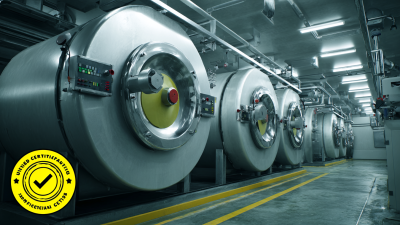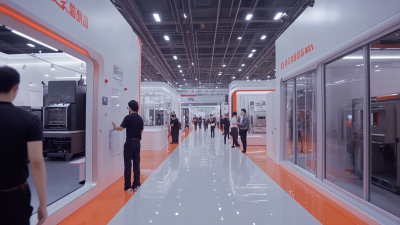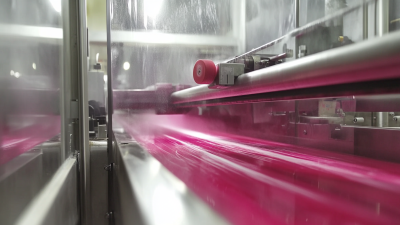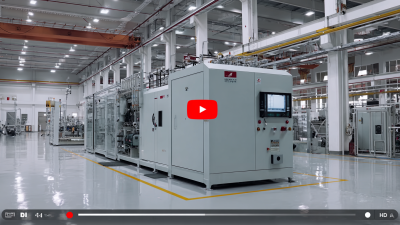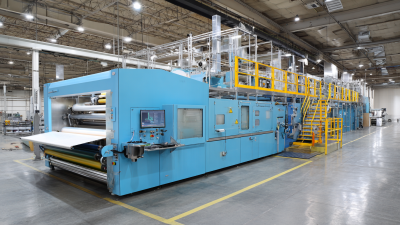
As we stand on the brink of a manufacturing revolution, the emergence of advanced technologies such as the Scraper Coating Machine is redefining the landscape of production processes. This innovative machinery not only enhances the efficiency and precision of coating applications but also addresses the growing demands for sustainability and adaptability in manufacturing environments. By introducing cutting-edge capabilities, the Scraper Coating Machine paves the way for smarter production lines, allowing for the seamless integration of various materials and enhancing product quality. This article delves into the transformative impact of this technology, exploring how it can be employed to streamline operations, reduce waste, and ultimately lead to a more sustainable and profitable future in manufacturing. Understanding the potential of the Scraper Coating Machine is crucial for industry leaders as they navigate the complexities of modern production challenges.

Innovative scraper coating machines are revolutionizing the manufacturing landscape by significantly enhancing production efficiency. These advanced machines utilize cutting-edge technology to apply coatings uniformly and precisely. As a result, manufacturers can achieve higher quality outputs with less waste, reducing both material costs and labor time. The precision of these machines ensures that each application meets stringent quality standards, which is essential in industries ranging from automotive to electronics.
Tips for maximizing the benefits of innovative scraper coating machines include regular maintenance and calibration. Keeping the machines in optimal working condition not only prolongs their lifespan but also ensures that they operate at peak efficiency. Additionally, it's crucial to train staff adequately on the operational aspects of these machines, as skilled operators can make the most of the technology by minimizing errors and optimizing production rates.
Another tip is to integrate a robust feedback loop into the production process. By analyzing data collected from scraper coating applications, manufacturers can continually refine their processes, leading to even greater efficiency gains over time. This proactive approach not only helps in identifying issues quickly but also fosters a culture of continuous improvement within the manufacturing environment.
| Parameter | Before Implementation | After Implementation | Improvement (%) |
|---|---|---|---|
| Production Speed (units/hour) | 80 | 120 | 50% |
| Material Waste (%) | 15 | 8 | 46.67% |
| Setup Time (minutes) | 30 | 15 | 50% |
| Labor Costs ($/hour) | 25 | 20 | 20% |
| Overall Equipment Effectiveness (%) | 65 | 85 | 30.77% |
The global painting tools market is on a significant upward trajectory, with its size expected to rise from USD 10.3 billion in 2024 to an impressive USD 13.95 billion by 2033, reflecting a compound annual growth rate (CAGR) of 3.4%. This growth can be attributed to the increasing demand for innovative equipment, particularly in the context of advanced scraper coating technologies. Manufacturers are actively seeking efficient solutions that enhance product quality and operational efficiency, driving the adoption of these new technologies.

As the market for scraper coating technologies expands, it will likely impact various facets of the manufacturing sector, including labor dynamics. The integration of innovative machinery represents not only a shift in equipment but also a transformation in the labor market. With the emergence of automated processes and smart manufacturing techniques, it is crucial for industry stakeholders and government bodies, such as the Bureau of Labor Statistics, to assess the implications on workforce skills and employment opportunities. This proactive approach in data collection and analysis will ensure that the labor force is well-prepared to adapt to the evolving landscape of manufacturing technologies.
 The integration of advanced scraper coating machine technology is revolutionizing the manufacturing landscape, primarily through its impact on cost reduction strategies. By automating the application of coatings, these machines minimize labor costs and human error, which traditionally contributed to inefficiencies in production processes. Moreover, the precision offered by modern scraper coating technology ensures consistent quality and optimal use of materials, further driving down expenses related to waste and rework.
The integration of advanced scraper coating machine technology is revolutionizing the manufacturing landscape, primarily through its impact on cost reduction strategies. By automating the application of coatings, these machines minimize labor costs and human error, which traditionally contributed to inefficiencies in production processes. Moreover, the precision offered by modern scraper coating technology ensures consistent quality and optimal use of materials, further driving down expenses related to waste and rework.
In addition to lowering direct costs, advanced scraper coating machines offer manufacturers the flexibility to respond swiftly to market demands. The ability to produce a variety of coatings with differing specifications on the same equipment allows companies to reduce downtime associated with equipment changeovers. This adaptability not only streamlines operations but also enhances the overall throughput, enabling manufacturers to maintain competitive pricing while still investing in innovation. As businesses embrace these cutting-edge technologies, the focus on cost reduction will be integral to sustaining growth and improving profitability in an increasingly competitive landscape.
The modern manufacturing landscape is increasingly focused on sustainability, particularly in high-impact sectors like offshore wind energy. The innovative scraper coating machine technology is revolutionizing the application of protective coatings on offshore wind farms, which are crucial for mitigating chemical emissions associated with corrosion. By utilizing advanced coating processes, manufacturers can minimize waste and enhance the durability of coatings, significantly reducing the environmental footprint of these operations.
Cathodic protection methods employed in offshore wind farms often involve the use of chemical agents that can pose environmental risks. As the industry evolves, adopting cleaner processes and innovative technologies, such as scraper coating machines, can lead to a notable decrease in hazardous emissions. These advancements not only improve the efficiency of applying protective coatings but also align with broader sustainability goals, as they focus on reducing the reliance on harmful chemicals. The integration of such technologies ultimately fosters a more responsible and eco-friendly approach to manufacturing in the offshore wind sector.
The evolution of manufacturing has been profoundly influenced by advances in scraping coating technology. Traditional scraper coating methods often rely on manual application, which can lead to inconsistencies in thickness and quality. These techniques typically involve the use of simple tools and require skilled labor to achieve desired results. While effective for small-scale production, these methods are increasingly seen as insufficient in meeting the demands of modern manufacturing, where speed, efficiency, and precision are paramount.
In contrast, innovative scraper coating technology integrates automation and advanced materials to optimize the coating process. These cutting-edge systems utilize precision machinery that can apply coatings uniformly and quickly, significantly reducing production times. Additionally, innovative techniques can accommodate a broader range of materials and reduce waste by ensuring that only the necessary amount of coating is applied. This shift not only enhances product quality but also contributes to sustainable manufacturing practices by minimizing environmental impact. As industries continue to seek competitive advantages, the transition from traditional to innovative scraper coating methods is poised to redefine manufacturing standards.
